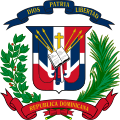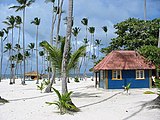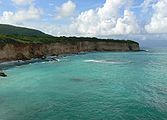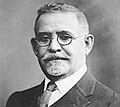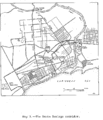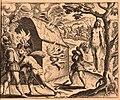Portal:Dominican Republic
Introduction
The Dominican Republic is a country on the island of Hispaniola in the Greater Antilles archipelago of the Caribbean Sea, bordered by the Atlantic Ocean to the north. It occupies the eastern five-eighths of the island, which it shares with Haiti, making Hispaniola one of only two Caribbean islands, along with Saint Martin, that is shared by two sovereign states. It is the second-largest nation in the Antilles by area (after Cuba) at 48,671 square kilometers (18,792 sq mi), and second-largest by population, with approximately 11.4 million people in 2024, of whom approximately 3.6 million live in the metropolitan area of Santo Domingo, the capital city. The Dominican people declared independence from Spain in November 1821. The colony of Santo Domingo was regionally divided with many rival and competing provincial leaders during the 1800s. Dominicans were often at war fighting against the French, Haitians, Spanish, or amongst themselves, resulting in a society heavily influenced by military strongmen. Santo Domingo attained independence as the Dominican Republic in 1844 when Dominican nationalists led an insurrection against the Haitians. Over the next decades, the Dominican Republic experienced several civil wars, battles against Haiti, and a brief return to Spanish colonial status, before permanently ousting the Spanish during the Dominican War of Restoration of 1863–1865. The U.S. occupied the Dominican Republic (1916–1924) due to threats of defaulting on foreign debts; a subsequent calm and prosperous six-year period under Horacio Vásquez followed. From 1930 the dictatorship of Rafael Leónidas Trujillo ruled until his assassination in 1961. Juan Bosch was elected president in 1962 but was deposed in a military coup in 1963. A civil war in 1965, the country's last, was ended by U.S. military intervention and was followed by the authoritarian rule of Joaquín Balaguer (1966–1978 and 1986–1996). Since 1978, the Dominican Republic has moved toward representative democracy. The Dominican Republic has the largest economy (according to the U.S. State Department and the World Bank) in the Caribbean and Central American region and is the seventh-largest economy in Latin America. Over the last 25 years, the Dominican Republic has had the fastest-growing economy in the Western Hemisphere – with an average real GDP growth rate of 5.3% between 1992 and 2018. GDP growth in 2014 and 2015 reached 7.3 and 7.0%, respectively, the highest in the Western Hemisphere. Recent growth has been driven by construction, manufacturing, tourism, and mining. The country is the site of the third largest (in terms of production) gold mine in the world, the Pueblo Viejo mine. (Full article...) Selected article -The Parsley massacre (Spanish: el corte "the cutting"; Creole: kout kouto-a "the stabbing") (French: Massacre du Persil; Spanish: Masacre del Perejil; Haitian Creole: Masak nan Pèsil) was a mass killing of Haitians living in the Dominican Republic's northwestern frontier and in certain parts of the contiguous Cibao region in October 1937. Dominican Army troops from different areas of the country carried out the massacre on the orders of Dominican dictator Rafael Trujillo. As a result of the massacre, virtually the entire Haitian population in the Dominican frontier was either killed or forced to flee across the border. Many died while trying to flee to Haiti across the Dajabón River that divides the two countries on the island; the troops followed them into the river to cut them down, causing the river to run with blood and corpses for several days. The massacre claimed the lives of an estimated 14,000 to 40,000 Haitian men, women, and children. Dominican troops interrogated thousands of civilians demanding that each victim say the word "parsley" (perejil). If the accused could not pronounce the word to the interrogators' satisfaction, they were deemed to be Haitians and killed. (Full article...)General images -The following are images from various Dominican Republic-related articles on Wikipedia.
Selected picture -Selected biography -Leonel Antonio Fernández Reyna (Pronunciation of "Leonel Fernández") (born 26 December 1953) is a Dominican lawyer, academic, and was the 50th and 52nd President of the Dominican Republic from 1996 to 2000 and from 2004 to 2012. From 2016 until 2020, he was the President of the EU–LAC Foundation. Fernández became the first elected president of the Dominican Republic under his political party, the Dominican Liberation Party (Partido de la Liberación Dominicana, or PLD), although party founder Juan Bosch was also sworn in as president in 1963 after the first democratic elections held in roughly four decades in the country. Fernández's administrations have focused much on technological and infrastructural development and macroeconomic and monetary stability. He has served as the party president of the Dominican Liberation Party from 2001 until his resignation on 20 October 2019. He later founded the People's Force and nominated himself as its party's presidential nominee. (Full article...)Related portalsWikiProjects
Things to do
Associated WikimediaThe following Wikimedia Foundation sister projects provide more on this subject:
SourcesDiscover Wikipedia using portals | |||||||||||||||||||||||||

